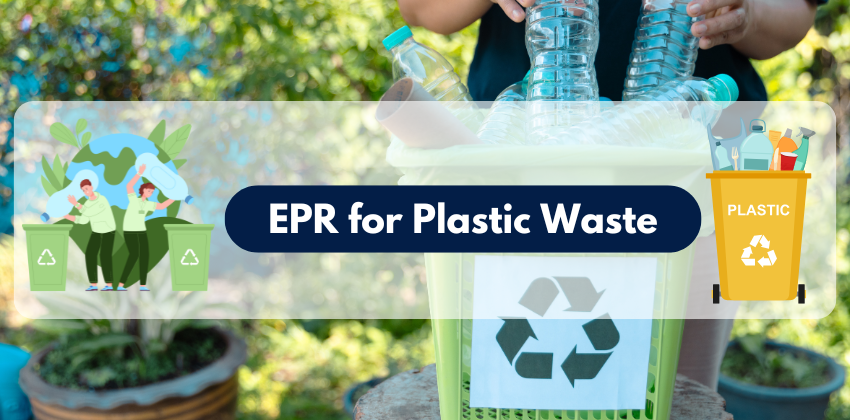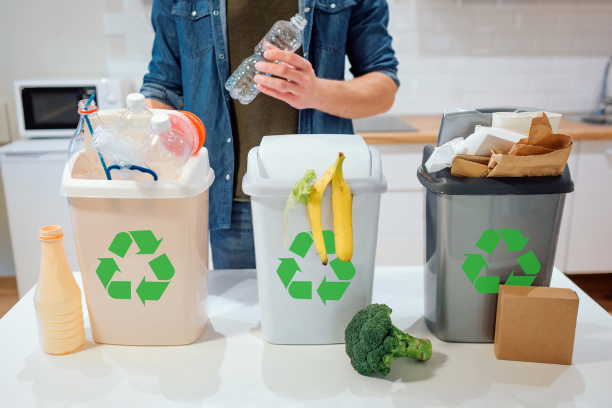
What does EPR for plastic waste mean?
EPR for plastic waste means extended producer responsibility for plastic waste. It defines the responsibility of the producer, importer, and brand owner (PIBO) to ensure the processing of their plastic packaging waste through recycling, reuse, or disposal in an environmentally sound manner. The Plastic Waste (Management) Rules 2016 deal with the responsibility of the producer, importer, or brand owner (PIBO) to ensure the proper recycling, reuse, or disposal of plastic packaging waste. E.g.
1. Plastic carry bags, plastic sheets, multilayer packaging, and covers made of plastic sheets are used to sell different kinds of finished and raw products like clothes, electronic products, etc.
2. multi-layered packaging for packaging or wrapping the commodity
FMCG (e.g., Milk packet, packed cooking oil in plastic bottles, water bottles, etc.)
Pharmaceutical (E.g., capsules and Tablets packed in plastic bottles, squeezable plastic bottles of eye drops/ Nasal spray, etc.)
Therefore, it covers all the industries that use plastic packaging for packing or wrapping their products.
What does plastic waste mean? What are the types of plastic packaging waste?
Plastic waste means any plastic discarded after use or after its intended use is over. There are two types of plastic packaging waste.
- 1. Pre-consumer plastic packaging waste: It refers to plastic packaging waste generated during the manufacturing of plastic packaging and during the packaging of products before they reach the end consumers of products.
- 2. Post-consumer Plastic Packaging Waste: It refers to plastic packaging waste generated by the end-user consumer after the intended use of packaging and packed product, and it also includes plastic carry bags.
What are the types of plastic packaging under EPR?
The following are the plastic packaging categories, which have been covered under EPR.
- Category I: Rigid Plastic Packaging, e.g., plastic bottles, jars, and tubes used for packaging of different products
- Category II: Flexible plastic, e.g., flexible plastic packaging of single-layer or multilayer (more than one layer with different types of plastic) plastic sheets or covers made of plastic sheets, carry bags, plastic sachets or pouches, e.g., plastic carry bags, stand-up pouches of dried fruits, products in zip-lock plastic packets, and other products in plastic pouches, etc.
- Category III: Multi-layered plastic packaging Multi-layered plastic packaging comprises at least one layer of plastic and at least one layer of plastic as the main ingredients in combination with one or more layers of material such as paper, paperboard, polymeric materials, metalized layers of aluminum foil, etc. E.g., multi-layered plastic packaging is generally used in the packaging of FMCG products like snacks, biscuits, edible oil, chocolates, etc.
- Category IV:- compostable plastics Compostable plastics means plastic that undergoes degradation by the biological process during compositing to yield carbon dioxide, water, inorganic compounds, and biomass at a rate consistent with other known compostable materials E.g., Plastic sheets or like used for packaging as well as carry bags, chips, masala packets, etc.
Which types of entities will be covered under the EPR obligation?
The following entities will be covered under the EPR obligation
- Producer of plastic packaging
- Importer of all imported plastic packaging and/ or plastic packaging of imported products
- Brand Owners including online platforms/ marketplace and supermarket/retail chains other than those, which are micro and small enterprises as per criteria of the Ministry of Micro, Small and Medium Enterprises, Government of India
- Plastic waste processor
Who is required to mandatorily obtain EPR Authorisation?
Plastic Waste (Management) Rules2016, provides that a producer, Importer, and brand owner (PIBO) is required to obtain the EPR authorization From the Central Pollution Control Board (CPCB). Extended producer responsibility shall be applicable to both pre-consumer and post-consumer plastic packaging waste.
procedure for Licence
What does mean by producer, importer, and Brand owner as per plastic waste (Management) Rules?
Following are the producer as per PWM Rules:-
- Brand owner: – Brand owner means a person or company who sells any commodity under a registered brand level or trademark.
- Importer:- Importer means a person who imports plastic packaging products or products with plastic packaging or carries bags or multilayered packaging or plastic sheets or like
- Producer:- Producer means a person engaged in manufacturing or import of carry bags or multilayer packaging or plastic sheets or like, including industries or individuals using plastic sheets or like or covers made of plastic sheets or multilayered packaging for packaging or wrapping the commodity.
Explanation:-
The term producer is a broad term that includes producer, importer, and brand owner.it is defined such that it includes any person, individual, or industry that is
- Manufacturing carry bags or multilayered packaging or plastic sheets or like
- Importing carry bags with multilayered packaging or plastic sheets
- Importing commodities packaged and wrapped in carry bags or multilayered packaging or plastic sheets or like
- Using plastic sheets or like or covers made of plastic sheets or multilayer packaging for packaging or wrapping the commodity for various sectors (Here word commodity word indicates all sectors such as pharmaceutical, FMCG, Construction, Automobile, etc.)
Is there any exemption for the Brand owner from fulfilling EPR obligations?
Brand owners who fall into micro & small categories are exempted from fulfilling EPR obligations.
Which type of persons are required to mandatorily register on the CPCB Portal?
The following persons are required to mandatorily register on the centralized portal developed by the Central Pollution Control Board (CPCB):
- A. Producer (P) B. Importer (I) C. Brand Owner (BO) D. Plastic Waste Processor engaged in:
- 1. Recycling 2. Waste to Energy 3. Waste to Oil 4. Industrial Composting
How can we help you?
We assist persons in obtaining EPR authorization by providing specialized services. We have an expert team that deals with these matters and provides proper guidance to our clients without manipulating the facts and are ensure to deliver the certificate and licence within a reasonable time period.
What are application Fees/ Annual Processing Which is required to be paid for EPR Registration of PIBOs??
Following are the application/ Registration fees to be by PIBO for EPR registration
| SL. No. | Plastic waste generated Tone per Annum (TPA) | Registration fee |
|---|---|---|
| 1 | Less than 1000 TPA | ₹10,000 |
| 2 | 1000 to 10000 TPA | ₹20,000 |
| 3 | More than 10000 TPA | ₹50,000 |
What is the EPR target for PIBO and how will this EPR target be calculated?
Calculation of Eligible quantity of plastic waste for determination of EPR Targets.
# In case of producer:-
Calculation of Eligible plastic waste for EPR Targets
Eligible plastic waste = A+B-C
Where,
A=Average weight of all plastic packaging material and / or plastic packaging of imported products ( category wise) sold in the last TWO Financial Year
B= Average quantity of pre-consumer plastic packaging in the last TWO Financial year
C= Annual supplies made to Brand owner including online platform/market place and super markets/ retail chain in the previous year
1. EPR Target :-
| SL. No. | YEAR | EPR Target = % of Eligible waste(MT) |
|---|---|---|
| 1 | 2021-2022 | 25% |
| 2 | 2022-2023 | 70% |
| 3 | 2023-2024 | 100% |
# In case of importer :-
Calculation of Eligible quantity of plastic waste for determination of EPR Targets.
# In case of producer:-
Calculation of Eligible plastic waste for EPR Targets
Eligible quantity = A+B-C
Where,
A=Average weight of all plastic packaging material and / or plastic packaging of imported products ( category wise) sold in the last TWO Financial Year
B= Average quantity of pre-consumer plastic packaging in the last TWO Financial year
C= Annual supplies made to Brand owner including online platform/market place and super markets/ retail chain in the previous year
1. EPR Target :-
| SL. No. | YEAR | EPR Target = % of Eligible waste(MT) |
|---|---|---|
| 1 | 2021-2022 | 25% |
| 2 | 2022-2023 | 70% |
| 3 | 2023-2024 | 100% |
#In case of Brand owner :-
Calculation of Eligible quantity of plastic waste for determination of EPR Targets.
# In case of producer:-
Calculation of Eligible plastic waste for EPR Targets
Eligible quantity = A+B
Where,
A= Average weight of virgin plastic packaging material (category wise) purchase and introduce in the market in the last TWO Financial years
B= Average quantity of pre- consumer plastic packaging in the last TWO Financial years
EPR Target :-
| SL. No. | YEAR | EPR Target = % of Eligible waste(MT) |
|---|---|---|
| 1 | 2021-2022 | 25% |
| 2 | 2022-2023 | 70% |
| 3 | 2023-2024 | 100% |
What is recycling and re-use target for PIBO?
In the case of producer:-
1. Obligation for recycling:-
The producer shall ensure minimum level of recycling of plastic packaging waste collected under EPR Target (category wise) as given below
(%of EPR Target)
| Plastic packaging category | 2024-25 | 2025-26 | 2026-27 | 2027-28 and onwards |
|---|---|---|---|---|
| Category I | 50% | 60% | 70% | 80% |
| Category II | 30% | 40% | 50% | 60% |
| Category III | 30% | 40% | 50% | 60% |
| Category IV | 50% | 60% | 70% | 80% |
B. Obligation for use of recycled plastic content :-
The producer shall ensure the use of recycled plastic in the plastic packaging category–wise as given below and this requirement is mandatory.
(% of Plastic Manufactured for the year)
| Plastic packaging category | 2025-26 | 2026-27 | 2027-28 | 2028-2029 on ward |
|---|---|---|---|---|
| Category I | 30% | 40% | 50% | 60% |
| Category II | 10% | 10% | 20% | 20% |
| Category III | 5% | 5% | 10% | 10% |
In the case of Importer:-
1. Obligation for recycling:-
The producer shall ensure minimum level of recycling of plastic packaging waste collected under EPR Target (category wise) as given below
(%of EPR Target)
| Plastic packaging category | 2024-25 | 2025-26 | 2026-27 | 2027-28 and onwards |
|---|---|---|---|---|
| Category I | 50% | 60% | 70% | 80% |
| Category II | 30% | 40% | 50% | 60% |
| Category III | 30% | 40% | 50% | 60% |
| Category IV | 50% | 60% | 70% | 80% |
2. Obligation for use of recycled plastic content :-
The producer shall ensure the use of recycled plastic in the plastic packaging category–wise as given below and this requirement is mandatory.
(% of Plastic Manufactured for the year)
| Plastic packaging category | 2025-26 | 2026-27 | 2027-28 | 2028-2029 on ward |
|---|---|---|---|---|
| Category I | 30% | 40% | 50% | 60% |
| Category II | 10% | 10% | 20% | 20% |
| Category III | 5% | 5% | 10% | 10% |
In case of brand owner :-
1. Obligation of recycling of plastic packaging waste
The Brand owner shall ensure minimum level of recycling of plastic packaging waste collected under EPR Target (category wise) as given below
(%of EPR Target)
| Plastic packaging category | 2024-25 | 2025-26 | 2026-27 | 2027-28 and onwards |
|---|---|---|---|---|
| Category I | 50% | 60% | 70% | 80% |
| Category II | 30% | 40% | 50% | 60% |
| Category III | 30% | 40% | 50% | 60% |
| Category IV | 50% | 60% | 70% | 80% |
Obligation for use of recycled plastic content
The Brand owner shall ensure use of recycled plastic in plastic packaging category –wise as given below and this requirement is mandatory.
(% of Plastic Manufactured for the year)
| Plastic packaging category | 2025-26 | 2026-27 | 2027-28 | 2028-2029 on ward |
|---|---|---|---|---|
| Category I | 30% | 40% | 50% | 60% |
| Category II | 10% | 10% | 20% | 20% |
| Category III | 5% | 5% | 10% | 10% |
Obligation for Reuse
The brand owners using category –I Plastic (rigid) plastic packaging for their products shall have minimum obligation to reuse such packaging as follow.
| SL. No. | Description | Year | Reuse Target (%) |
|---|---|---|---|
| A | Category I rigid plastic packaging with volume/weight ≥ 0.9L/Kg but < 4.9L/Kg | ||
| I | – | 2025-26 | 10% |
| II | – | 2026-27 | 15% |
| III | – | 2027-28 | 20% |
| IV | – | 2028-29 onwards | 25% |
| B | Category I rigid plastic packaging with volume/weight ≥ 4.9L/Kg | ||
| I | – | 2025-26 | 70% |
| II | – | 2026-27 | 75% |
| III | – | 2027-28 | 80% |
| IV | – | 2028-29 onwards | 85% |
Note- Only those plastics which cannot be recycled will be sent for end of life disposal such as road construction, waste to energy, waste to oil, cement kilns (for co processing) as per relevant guidelines issued by Indian road congress or Central pollution control Board from time to time.
How can we help you?
We assist persons in obtaining EPR authorisation by providing specialized services. We have an expert team that deals with these matters and provide proper guidance to our clients without manipulating the facts and make ensure to deliver the certificate and licence within a reasonable time period.
So If you are looking for EPR for Plastic Waste, you are on the correct place, call us or fill the form to consult with us.

Need more help?
Feeling inquisitive? Have a read through some of our FAQs or contact our Supporters for help
Frequently asked questions
Importer: Brings plastic packaging or packaged goods into India.
Brand Owner: Sells products under a registered brand/trademark.












